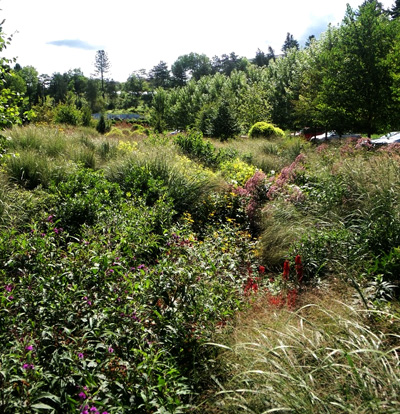
Rain gardens, filter strips and bioswales are a great way to help reduce runoff, flooding and pollution while increasing groundwater infiltration and aquifer recharge – especially in urban areas.
These stormwater prevention practices are often planted with herbaceous plants such as swamp milkweed, soft rush and Joe-Pye weed that tolerate periodic flooding while also surviving dry periods between storms. But these plant need to be cut back annually after their leaves and stems die back to the ground.
Carefully chosen woody shrubs, on the other hand, can do the same job with less maintenance. Plus they can provide aesthetic benefits, year-round interest, shade and wildlife habitat all while removing and sequestering carbon dioxide – a greenhouse gas – from the atmosphere.
To help choose the right shrub for these uses, the Department of Horticulture’s Urban Horticulture Institute (UHI) has just released a 56-page guide, Woody Shrubs for Stormwater Retention Practices (Northeast and Mid-Atlantic Regions). The guide details site assessment and design considerations for those practices and profiles more than 35 woody shrub species that can tolerate both dry and periodically saturated soil conditions typical of retention areas.
The guide is based in part on a study conducted in Ithaca, N.Y., by Master of Professional Studies student Ethan M. Dropkin guided by co-author and UHI director Nina Bassuk. The study tested the flood and drought tolerances of six of the shrub species included in the guide.
Free electronic versions of the guide are available through the outreach section of the UHI website: http://www.hort.cornell.edu/uhi/outreach/


